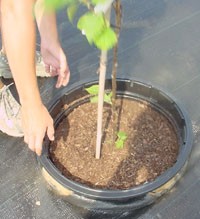Pot-in-pot Nursery Production May Provide New Crop Opportunity
Pot-in-pot Nursery Production May Provide New Crop Opportunity

The production of trees and shrubs using a system called pot-in-pot has been increasing in the United States in recent years.
 A demonstration of this technique can be seen at the University of Kentucky Research and Education Center in Princeton and will be a part of the July 18 field day events.
A demonstration of this technique can be seen at the University of Kentucky Research and Education Center in Princeton and will be a part of the July 18 field day events.
The demonstration is being funded through money the Kentucky Horticulture Council received from the federal Phase 1 Tobacco Settlement. Overseeing the plot is Amy Fulcher, Extension horticulture associate under the direction of Robert McNiel, UK horticulture specialist.
Pot-in-pot is a system that is somewhat new and not that common in Kentucky but is found in larger nursery production areas such as Illinois and Ohio, McNiel said. Interest in it in Kentucky is growing, at least verbally, he said.
Pot-in-pot research began in Kentucky about eight years ago. Today, cyclic irrigation research is under way in Lexington.
This system is a hybrid of field and above ground container production. It uses a technique of growing trees and shrubs in pots that have been placed inside other pots that are permanently placed in the ground. Only trees are being used by UK researchers.
One advantage of the system is that a grower can harvest anytime unlike with field production where, because the root system is being severed, harvest is limited to spring and fall. Also, moisture can limit harvest because it has to allow for the making of a root ball.
With pot-in-pot, the trees are not prone to tipping over as they are in above ground container systems which can result in damage as well as lost water and fertilizer. Spacing between plants in this production system is similar to other systems.
Above ground container production is not done in Kentucky, McNiel said, because there is no good way to protect the plants from weather extremes and there is too much wind.
The key to a successful system is to get it installed properly.
A grower will need a high quality, reliable water source. Micro irrigation with spray stakes is used to water the trees. Heavy grade landscape fabric is used between the pots to reduce weed pressures.
"Oftentimes, you get a better quality plant because you are micro managing the water and fertilizer and controlling the substrate it is growing in," Fulcher said.
A drain system likely will be needed.
"In Kentucky, we've found most soils to be too heavy to drain well without a drain system. The system is necessary otherwise the plants would stay flooded after heavy rains," she said.
It is best to buy pots specifically designed for the system. The socket pots need to be strong and the pots in which the plants will be grown need to fit snugly into the socket pot.
If someone is considering this system for next year, they need to install the system now and begin looking for the bareroot plants they want for spring delivery, or consider purchasing plants already growing in containers to use this season, Fulcher said.
Input costs are similar to that of field production, but more of the cost is at the beginning with the pot-in-pot nursery production system, McNiel said.
In addition to the demonstration site at Princeton, Fulcher will be working with tobacco growers in west Kentucky who are interested in pot- in-pot nursery production as another enterprise. The plans are to have three additional demonstration sites on farms in western Kentucky. Potential growers have been identified and details are being finalized. Fulcher will help with the installation at the demonstration sites and will make monthly visits to provide technical expertise.
